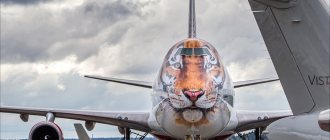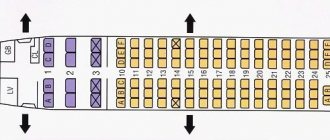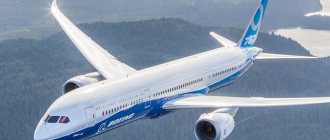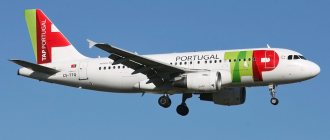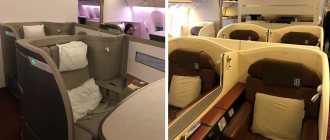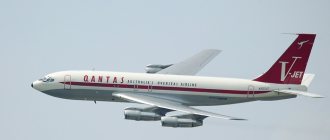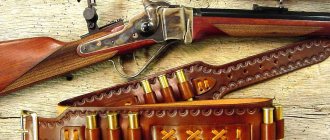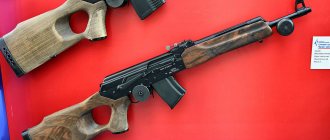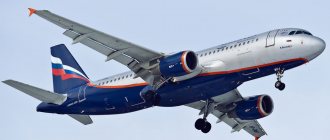The latest Airbus model appeared on the market in the summer of 2016. There are a number of aircraft of this brand used by Aeroflot. Wikipedia reports that the airliner flies 14,800 kilometers, this allows you to reach the easternmost edge of Russia and go to New York or Singapore directly from Moscow.
Singapore Airlines is an international company that operates the Airbus A350 in its fleet. Planes fly to 40 countries, landing at 90 airports. There are currently 11 airliners in the fleet, and it is planned to purchase another 56 Airbus 350 900 aircraft, which should replace the 300 model and Boeing 777.
The plane is also used by Qatar Airways.
Airbus 350 characteristics and seat maps
The aircraft manufacturer produces Airbus A350 in three main modifications with different flight characteristics and passenger cabin layouts. Fuselage length (three versions of the A350) – 60.5 m/66.8 m/73.8 m, width – 5.96 m. Cruising speed – 903 km/h, maximum – 945 km/h. Flight range – 14.8/15.0/15.2 km.
The A350 aircraft is equipped with a fly-by-wire remote control system and a comfortable cabin for passengers of three classes of service. The seats in the cabin have an increased width (3.9 cm more than in the Airbus A330), and more spacious shelves for hand luggage. The latest navigation technologies have been introduced into the cockpit. The cabin is designed for two crew members.
A350-900 interior layout
The comfortable cabin of the Airbus A350-900 accommodates 293 passengers. The first eight rows are a business class cabin with a capacity of 48 people. The seats are arranged in three rows in a 2x2x2 layout.
The second sector (12, 14, 15 rows) is a premium economy with an improved layout and an expanded space between the seats in a row. The passenger capacity of the cabin is 21 people. The seats are arranged in a 2x3x2 pattern.
From 16 to 42 – economy class of service, designed to carry 224 passengers. The salon is divided into two sectors: the first - from 16 to 26, the second - from 27 to 41 rows. The seats are installed according to a 3x3x3 pattern, with the exception of some rows: in the 16th and 27th rows the seat arrangement is 2x3x2, in the last 42nd row, 3 seats are installed only in the middle row. On the sides there is a partition behind which there is a toilet.
The A350 has several kitchens, technical rooms and bathrooms for passengers of different service classes. Between rows 6-7 and 26-27 there are emergency hatches.
Business Class
The best seats are at the bow of the ship. On an Airbus, these 48 seats are located in rows 1 to 12 with two aisles.
For passenger comfort we offer:
- priority right to board;
- two wide aisles between rows;
- soft and comfortable seats, which in some Airbus models fold out like beds;
- convenient seating arrangement - “1-2-1”;
- each chair is placed at an angle, which increases free legroom;
- exquisite food and wine menu;
- multimedia leisure system and Wi-Fi.
However, seats in rows 1 and 12 are the most troublesome among business class seats, because located near utility rooms and toilets, the area near them is also illuminated at night.
Lufthansa and Singapore Airlines use a division into 3 classes: in addition to business and economy, premium economy is distinguished. Special panels separate seats 20–21 from the economy zone; here both the seats themselves and the distance between them are slightly wider. Passengers are allowed to carry more luggage, and almost “business” quality meals are offered during the flight.
Where is the best place to sit on a plane?
The Airbus A350 has enhanced comfort seats with increased legroom. Some rows in the cabin have disadvantages, against which the planned flight may not be very comfortable. Airbus A350 passengers can select the most comfortable seat on the plane in advance and reserve it for themselves using the airline's special service.
Comfortable and uncomfortable seats in the A350-900 with 293 seats:
- The business class cabin has the most comfortable seats for the flight. There is an expanded space between the seats. The seats are equipped with a multifunctional mode that allows you to lower the backrest by 180 degrees. The seats in the last row of the cabin are considered less convenient for flying in business class, as they are located close to the toilets.
- Superior Economy is an equally comfortable cabin for air travel. Between the seats in the row there is increased legroom (97 cm).
- In row 12, passengers are not allowed to place hand luggage under their feet.
- In economy class, the most comfortable seats are considered to be seats A and K on row 28 (second economy cabin).
- Row 16 has expanded legroom. The disadvantage of the row is that the folding tables are attached to the armrests of the chairs, which makes them immovable.
- The most uncomfortable seats in the A350 are D, E, G on the 27th row (reduced seat width), 41st and 42nd rows - close to the toilets, as well as blocked seat backs.
The standard spacing between seats in the economy row is 78 cm.
Each air carrier operates Airbus A350s with different cabin layouts. To choose comfortable seats on an airliner, first study the cabin layout of a specific aircraft operated by the company chosen for the flight.
Economy class
The economy class cabin follows the business cabin. The numbering of its seats begins with 13 and ends with 41 (with a 2-class layout). Seats are arranged 3 in a row according to the “3-3-3” pattern. Sufficient comfort is provided by:
- two aisles between seats;
- soft chairs with armrests, recline back to a certain angle;
- standard distance between seats (80 cm);
- wide selection of dishes and drinks, incl. additional.
Seats in the 13th row are suitable for passengers with small children - they are equipped with special devices for infants. There's also more legroom, with no forward seating or reclining seats. This is where the distribution of food and drinks begins.
Comfortable are two seats in the 14th row with the letters C and G and the seats in the 26th row of the second section (see diagram) - there are also no people sitting in front.
Calmness and complete comfort should not be expected on the seats in rows 25, 40, 41 - they are located close to the toilet rooms and utility rooms. And people with a weak vestibular system are not recommended to buy tickets for the 41st row - due to the limited view in the windows, they may feel dizzy.
Which airlines operate the A350?
Today, the modern Airbus A350 is used for long-haul passenger transportation by 23 airlines around the world.
The most famous A350 operators:
- China Airlines is the national carrier of Taiwan, using 14 aircraft of this model;
- Lufthansa, the flag carrier of Germany, maintains 10 A350-900 aircraft in its fleet, with another 15 aircraft expected to be delivered over the next 5 years;
- Asiana Airlines - the South Korean airline operates 6 Airbus 350s on its flights and expects the delivery of another 24 custom-made aircraft;
- Thai Airways, the national carrier of Thailand, has 12 Airbus A350s in its fleet.
Airliners of this model are not yet in operation in Russia.
Articles about other Airbus aircraft:
Review of the Airbus A330 aircraft: characteristics, cabin layout, best seats Review and diagram of the Airbus A300 passenger airliner Characteristics and diagram of the Airbus A310 passenger aircraft Description, models and cabin diagram of the Airbus A340 airliner Description and diagram of the Airbus A319 passenger airliner Airbus A320 - review, cabin layout, where is the best place to sit Sukhoi Superjet 100 - characteristics and best seats on the plane New rules for the permissible weight of baggage on the plane and hand luggage Safety rules in emergency situations on board the plane
Aeroflot presented the Airbus A350-900
On March 4, 2022, Aeroflot presented the first aircraft of this type in Russia at Sheremetyevo. The presentation was attended by representatives of the media, who were one of the first to carry out a demonstration flight on an airplane. This aircraft will begin operating regular flights on March 6.
Aeroflot has already opened the sale of tickets for a new type of aircraft. In 2020, the Airbus will operate flights to the following destinations: Delhi, London, New York, Miami and Tel Aviv. There is no information about domestic flights yet. It is known that starting March 29, planes will fly from Moscow to New York.
From May 1, the Airbus A350-900 will operate flights to Beijing, from June 1 – to Seoul and from June 2 – to Miami. The new airbus received a certificate from the Russian aviation authorities. This document was issued by the Federal Air Transport Agency after extensive collaboration with the participation of Airbus specialists.
Versions and modifications of the Airbus 350 aircraft
The aircraft manufacturer has created the modern Airbus A350 in several versions, distinguished by some technical characteristics and the layout of the passenger compartment.
A350 modifications:
- A350-900 – basic version, in operation since 2014. Flight range when fully loaded is 15,000 km. Salon of three classes of service, capacity for 325 people.
- A350-900R – increased flight range by 1500 km.
- A350-900 F is a cargo airliner with a flight range of up to 9,300 km.
- A350-800 is a shortened version of the Airbus with a three-class cabin layout with 280 seats.
- A350-1000 is an aircraft with an extended fuselage (74 m), accommodating 366 passengers. Flight range – 14,800 km. The largest of the Airbus A350 family.
- ACJ350 is a private jet with a cozy cabin for 30 people with all the necessary amenities for a comfortable flight.
- The A350ULR is an ultra-long-haul airbus capable of covering distances without refueling for 19 hours.
The Airbus A350 is a modern airliner characterized by high profitability, reliability and comfort for flying passengers over long distances. Today, the European manufacturer produces aircraft of this model to order from airlines. A further 164 units are expected to be delivered over the next few years.
Between 2022 and 2025. Airbuses A350-900 will join the fleet of the major Russian carrier Aeroflot. The company expects the delivery of 28 aircraft with a three-class cabin layout with 314 seats.
Design features
The design of the aircraft primarily determines its weight and operating cost. The use of the latest composite materials (52% of the aircraft weight), aluminum (20%), titanium (14%), steel (7%) in the A350 helped reduce weight (per passenger) by 14% and cost by 10%. operation compared to the similar Boeing 787 aircraft. This main competitor also uses composites (50%), aluminum (20%), titanium (15%), steel (10%), and other materials (5%).
The latest materials have made it possible to create the largest wing (among those developed for single-deck liners). Its characteristics are:
- area - 443 m²;
- span - 64.8 m, which is 4.5 m greater than the wing span of the A330 and the original A350 model, and slightly overlaps the wing size of the Boeing 777-200LR/777-300ER;
- sweep - 31.9°, which directly affects the increase in speed;
- saber-shaped wing tips curved upward on the last 4.4 m, which is original to the Airbus line;
- development and application of new mechanisms.
Interesting!
To improve aerodynamic performance, the configuration of the wings and their tips was tested in low- and high-speed wind tunnels (about 4000 hours), and the A350 designer also applied computational fluid dynamics. The Trent XWB family power plant, which is used in all modifications, consists of two engines, fans, is equipped with an auxiliary power unit and a Hamilton Sundstrand aircraft turbine, which in the event of an accident can provide a power supply of 100 kVA, increasing flight safety.
History of creation
The emergence of the Airbus A350 is due to competition with the Boeing 787 Dreamliner project. In the announcement of this relatively new aircraft, Boeing announced a reduction in operating costs. This could seriously displace the Airbus A330 in the aviation market. However, at first the French company Airbus doubted the ability of competitors to beat its new A330 aircraft. But at the insistence of air carriers, it began developing a new version of this aircraft (its unofficial name is “A330-200Lite”).
The competition was based on the following characteristics:
- fuel economy (Boeing stated that the 787 model will reduce fuel consumption by 20%);
- improving aerodynamics;
- improvement of engines.
The initial version in 2004 radically changed the design, which did not suit the airline. And having significantly increased funding (up to 4 billion euros), the corporation began designing and implementing a practically new airliner, the A350 XWB (Extra Wide Body).
The Airbus 350 prototype first took to the skies on June 14, 2013 in Toulouse-Blagnac, France. The type certificate was issued by the European Aviation Safety Agency for the A350-900 variant with Rolls-Royce Trent XWB engines on September 30, 2014. Entry into service was scheduled for summer 2014.
The first commercial flight from Qatar to Germany (Doha-Frankfurt) was made in 2015. The following year, the liners were operated by 10 air carriers. The longest flight was also made, a distance of 11,330 km, which took 14 hours - from Adelaide in the south of Australia to Doha.
The first A350-1000 was assembled in 2016 and took off in November. Start of operation - 2022
To create the A350, Airbus built 10 new factories in Western Europe (Lufthansa in Germany, etc.) and the USA, and existing sites were expanded. The plan from 2022 is to release 10 aircraft every month. Innovations were also introduced into the production process, which reduced assembly time.
